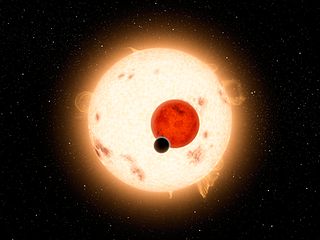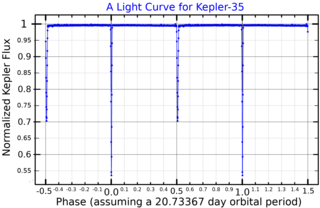HD 20782 is a 7th magnitude G-type main sequence star 117.5 light-years away from Earth, in the constellation of Fornax. HD 20782 is a part of a wide binary system in which the other star is designated HD 20781, and both stars host planetary systems. Indeed, this is the first known case of a binary star system where there are planetary systems around both the primary and the secondary stars in the system. The companion star HD 20781 has a very large angular separation of 252 arcsec, corresponding to 9080 AU at the distance of HD 20782. It is estimated to be 7.1 billion years old, with a mass close to that of the Sun.
HAT-P-6 also named Sterrennacht is a star in the constellation Andromeda, located approximately 895 light years or 274 parsecs away from the Earth. It is an F-type star, implying that it is hotter and more massive than the Sun. The apparent magnitude of the star is +10.54, which means that it can only be visible through the telescope. The absolute magnitude of +3.36 is brighter than the Sun's +4.83, meaning that the star itself is brighter than the Sun. A search for a binary companion star using adaptive optics at the MMT Observatory turned out negative.
WASP-11/HAT-P-10 is a binary star. It is a primary main-sequence orange dwarf star. Secondary is M-dwarf with a projected separation of 42 AU. The system is located about 424 light-years away in the constellation Aries.
HAT-P-7 is a F-type main sequence star located about 1088 light-years away in the constellation Cygnus. The apparent magnitude of this star is 10.5, which means it is not visible to the naked eye but can be seen with a small telescope on a clear dark night.

NN Serpentis is an eclipsing post-common envelope binary system approximately 1670 light-years away. The system comprises an eclipsing white dwarf and red dwarf. The two stars orbit each other every 0.13 days.

Kepler-10, formerly known as KOI-72, is a Sun-like star in the constellation of Draco that lies 607 light-years from Earth. Kepler-10 was targeted by NASA's Kepler spacecraft, as it was seen as the first star identified by the Kepler mission that could be a possible host to a small, transiting exoplanet. The star is slightly less massive, slightly larger, and slightly cooler than the Sun; at an estimated 11.9 billion years in age, Kepler-10 is almost 2.6 times the age of the Sun. Kepler-10 is host to a planetary system made up of at least three planets. Kepler-10b, the first undeniably rocky planet, was discovered in its orbit after eight months of observation and announced on January 10, 2011. The planet orbits its star closely, completing an orbit every 0.8 days, and has a density similar to that of iron. The second planet, Kepler-10c, was confirmed on May 23, 2011, based on follow-up observations by the Spitzer Space Telescope. The data shows it has an orbital period of 42.3 days and has a radius more than double that of Earth, but it was initially thought to have a higher density, making it the largest and most massive rocky planet discovered as of June 2014. However, refined mass measurements have shown it to be a more typical volatile-rich planet. A third planet, Kepler-10d, was discovered in 2023 by radial velocity observations.
Kepler-41 or KOI-196 is a star in the constellation Cygnus. It is a G-type main-sequence star, like the Sun, and it is located about 3,68 light-years away. It is fairly similar to the Sun, with 115% of its mass, a radius of 129% times that of the Sun, and a surface temperature of 5,750 K. Search for stellar companions to Kepler-41 in 2013-2014 has yielded inconclusive results, compatible with Kepler-41 being the single star.
Kepler-19 is a G7V star that is host to three known planets - Kepler-19b, Kepler-19c, and Kepler-19d. It is located about 720 light-years away in the constellation Lyra, five arcminutes northwest of the much more distant open cluster NGC 6791.

Kepler-16 is an eclipsing binary star system in the constellation of Cygnus that was targeted by the Kepler spacecraft. Both stars are smaller than the Sun; the primary, Kepler-16A, is a K-type main-sequence star and the secondary, Kepler-16B, is an M-type red dwarf. They are separated by 0.22 AU, and complete an orbit around a common center of mass every 41 days. The system is host to one known extrasolar planet in circumbinary orbit: the Saturn-sized Kepler-16b.
HAT-P-17 is a K-type main-sequence star about 92.6 parsecs (302 ly) away. It has a mass of about 0.857 ± 0.039 M☉. It is the host of two planets, HAT-P-17b and HAT-P-17c, both discovered in 2010. A search for a binary companion star using adaptive optics at the MMT Observatory was negative. A candidate companion was detected by a spectroscopic search of high-resolution K band infrared spectra taken at the Keck observatory.
Kepler-22 is a Sun-like star in the northern constellation of Cygnus, the swan, that is orbited by a planet found to be unequivocally within the star's habitable zone. It is located at the celestial coordinates: Right Ascension 19h 16m 52.2s, Declination +47° 53′ 3.9″. With an apparent visual magnitude of 11.7, this star is too faint to be seen with the naked eye. It can be viewed with a telescope having an aperture of at least 4 in (10 cm). The estimated distance to Kepler-22 is 644 light-years.
Kepler-20 is a star about 934 light-years from Earth in the constellation Lyra with a system of at least five, and possibly six, known planets. The apparent magnitude of this star is 12.51, so it cannot be seen with the unaided eye. Viewing it requires a telescope with an aperture of 15 cm (6 in) or more. It is slightly smaller than the Sun, with 94% of the Sun's radius and about 91% of the Sun's mass. The effective temperature of the photosphere is slightly cooler than that of the Sun at 5466 K, giving it the characteristic yellow hue of a stellar class G8 star. The abundance of elements other than hydrogen or helium, what astronomers term the metallicity, is approximately the same as in the Sun. It may be older than the Sun, although the margin of error here is relatively large.

Kepler-35 is a binary star system in the constellation of Cygnus. These stars, called Kepler-35A and Kepler-35B have masses of 89% and 81% solar masses respectively, and both are assumed to be of spectral class G. They are separated by 0.176 AU, and complete an eccentric orbit around a common center of mass every 20.73 days.
Kepler-68 is a Sun-like main sequence star located 471 light-years away in the constellation Cygnus. It is known to have at least four planets orbiting around it. The third planet has a mass similar to Jupiter but orbits within the habitable zone.

Kepler-78b is an exoplanet orbiting around the star Kepler-78. At the time of its discovery, it was the exoplanet most similar to Earth in terms of mass, radius, and mean density.
Kepler-102 is a star 353 light-years away in the constellation of Lyra. Kepler-102 is less luminous than the Sun. The star system does not contain any observable amount of dust. Kepler-102 is suspected to be orbited by a binary consisting of two red dwarf stars, at projected separations of 591 and 627 AU.

HD 179070, also known as Kepler-21, is a F-type subgiant star 354 light-years away in the constellation Lyra. A transiting exoplanet was discovered orbiting this star by the Kepler spacecraft. At a magnitude of 8.25 this was the brightest star observed by Kepler to host a validated planet until the discovery of an exoplanet orbiting HD 212657 in 2018.
Kepler-411 is a binary star system. Its primary star Kepler-411 is a K-type main-sequence star, orbited by the red dwarf star Kepler-411B on a wide orbit, discovered in 2012.
Kepler-167 is a K-type main-sequence star located about 1,119 light-years (343 pc) away from the Solar System in the constellation of Cygnus. The star has about 78% the mass and 75% the radius of the Sun, and a temperature of 4,884 K. It hosts a system of four known exoplanets. There is also a companion red dwarf star at a separation of about 700 AU, with an estimated orbital period of over 15,000 years.






